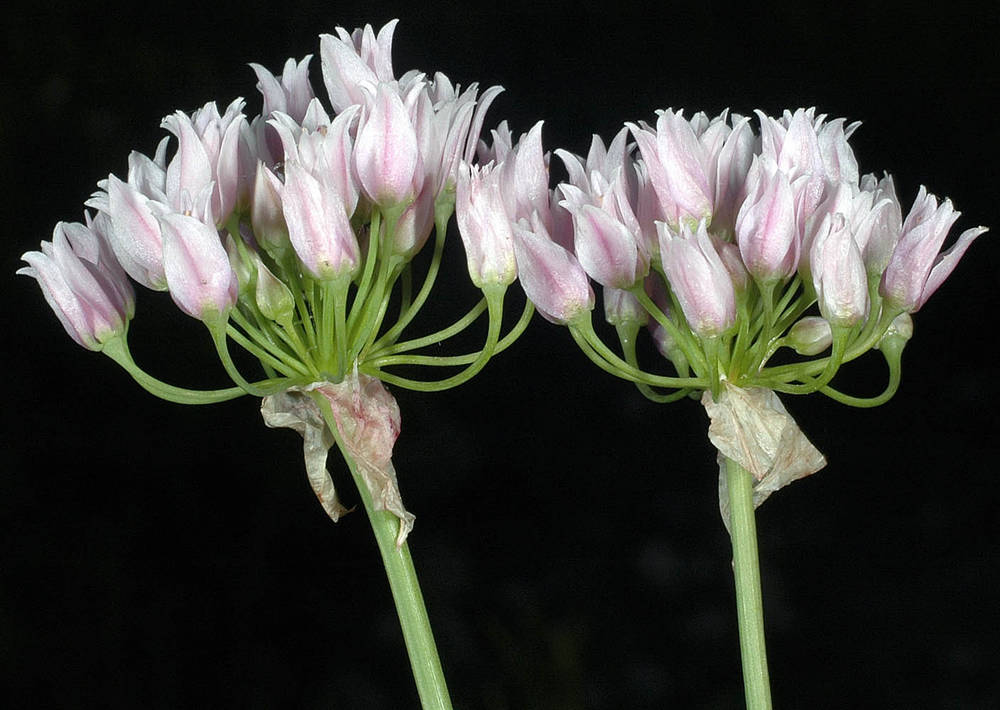Allium geyeri
Allium campanulatum
Geyer's onion
Sierra onion
2–10+; ovoid or slightly elongate;
outer coats enclosing 1 or more bulbs, reticulate;
cells rather coarse-meshed; open, fibrous.
1–3, producing cluster of stalked basal bulbils above roots or filiform rhizomes to 10 cm and terminated by bulbils; ovoid;
outer coats enclosing 1 or more bulbs, membranous, cellular-reticulate;
cells more or less quadrate;
walls very sinuous; without fibers.
persistent, usually green at anthesis, usually 3–5;
blades solid; more or less straight; flat, channeled; (6)12– 30 cm × 1–3(5) mm.
persistent, withering from tip by anthesis, 2;
blades solid; flat, distinctly concave-convex, 8–40 cm × 1–5 mm.
persistent; solitary; erect; terete or somewhat 2-angled, 10–50 cm × 1–3 mm.
persistent; solitary or clustered, 1–3; erect; solid; terete, 10–30 cm × 1–5 mm.
persistent; erect; compact, 10–25-flowered, hemispheric to globose, not producing bulbils, or 0–5-flowered, largely replaced by ovoid, acuminate bulbils;
pedicels becoming rigid and stiffly spreading in fruit, 8–13 mm;
spathe bracts 2–3.
persistent; erect; loose, 10–50-flowered; more or less globose;
pedicels 10–20 mm, becoming flexuous and mostly strongly deflexed in fruit;
spathe bracts 2–3.
(4)6–8(10) mm;
tepals erect or spreading; ovate to lanceolate; more or less equal, pink to white;
margins often obscurely toothed;
apex obtuse to acuminate;
stamens included;
ovary when present, inconspicuously crested with 3–6 low processes;
stigma unlobed or obscurely lobed.
5–8 mm;
tepals spreading, lanceolate to ovate; more or less equal; rose to purple (rarely white) with darker purple basal crescent on ventral side, keeled in fruit, becoming erect; more or less shiny; rigid;
margins entire;
apex acuminate, strongly involute at tip;
stamens included;
ovary crested with 6 prominent processes;
stigma scarcely thickened, unlobed.
=14, 28.
Allium geyeri
Allium campanulatum
2 varieties.
Usually sandy soils and rocky uplands, on open or shaded slopes. Flowering May–Aug. 600–2400 m. BR, BW, ECas, Sisk. CA, NV. Native.
Nick Otting, Richard Brainerd, Barbara Wilson
Nick Otting, Richard Brainerd, Barbara Wilson
- Local floras:
BC,
OR,
WA
- Local Web sites:
Flora NW,
PNW Herbaria
WildflowerSearch
iNaturalist (observations)
USDA Plants Database
- LBJ Wildflower Center
- SEINet
- Plants of the World Online
- Encyclopedia of Life
- Wikipedia
- Google Image Search





